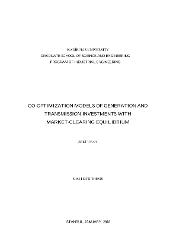| dc.contributor.advisor | Çelebi, Emre | en_US |
| dc.contributor.author | Uyan, Zeki | |
| dc.date.accessioned | 2019-07-12T08:42:23Z | |
| dc.date.available | 2019-07-12T08:42:23Z | |
| dc.date.issued | 2018 | |
| dc.identifier.uri | https://hdl.handle.net/20.500.12469/2553 | |
| dc.description.abstract | Methods for co-optimizing transmission and generation investments including bi-level or multi-level problems consider trade-offs with market operations and interactions in electric power supply and demand. Under fairly general conditions it is known that simultaneous solution of these multi-level models using complementarity problems can give more useful results than iterative optimization methods or single-level optimization of generation or transmission expansion alone. Hence in this thesis we provide mixed complementarity problem formulations for transmission and generation expansion models with electricity market-clearing models. in this study we have considered co-optimization models formulated as bi-level programming problems as well as single-level mixed complementarity problems. in the upper level of the bi-level problem the system operator decides on the transmission expansion plans while anticipating the decisions in the lower level of the problem. The lower level problems present models of generation expansion and oligopolistic competition among power generators in the market where we examine perfect competition models to Cournot game among generators. This model is essentially an economic equilibrium problem for electricity markets that is defined by the optimality conditions that examine system operator’s and generators’ expansion behavior along with supply-demand balance in the market. These models will be handful for planning generation/transmission expansions and analyzing the relations between these expansions and the market outcomes. We have simulated market outcomes and expansion decisions in a 6-bus test system and a realistic Turkish electricity market under two different market structures (perfect competition and Nash-Cournot). Furthermore four different scenarios considering carbon costs and feed-in-tariffs (FiT) for Turkish electricity market for December 2020 are simulated and results are examined. Scenario considering both carbon costs and FiT have provided relatively better results in terms of social welfare. | en_US] |
| dc.language.iso | eng | en_US |
| dc.publisher | Kadir Has Üniversitesi | en_US |
| dc.rights | info:eu-repo/semantics/openAccess | en_US |
| dc.subject | Co-optimization | en_US |
| dc.title | Co-optimization models of generation and transmission investments with market-clearing equilibrium | en_US |
| dc.type | masterThesis | en_US |
| dc.department | Enstitüler, Lisansüstü Eğitim Enstitüsü, Endüstri Mühendisliği Ana Bilim Dalı | en_US |
| dc.relation.publicationcategory | Tez | en_US |
| dc.identifier.yoktezid | 498346 | en_US |
















